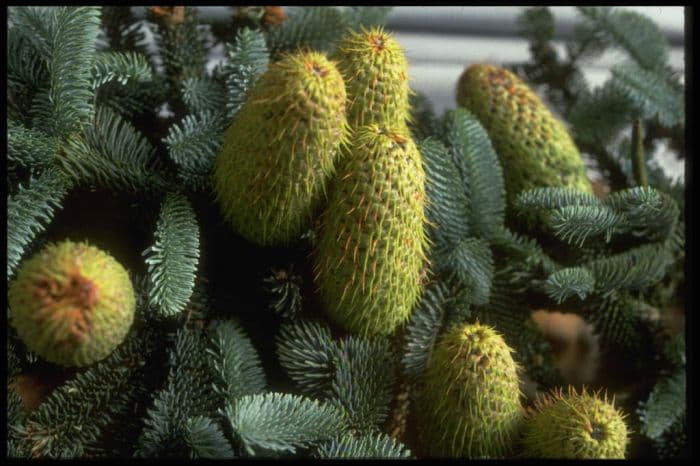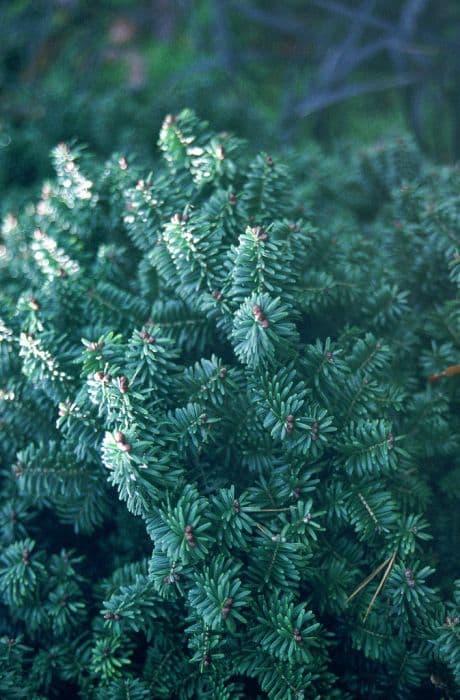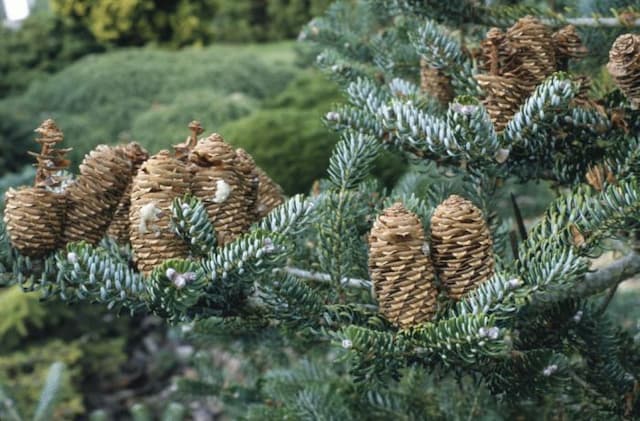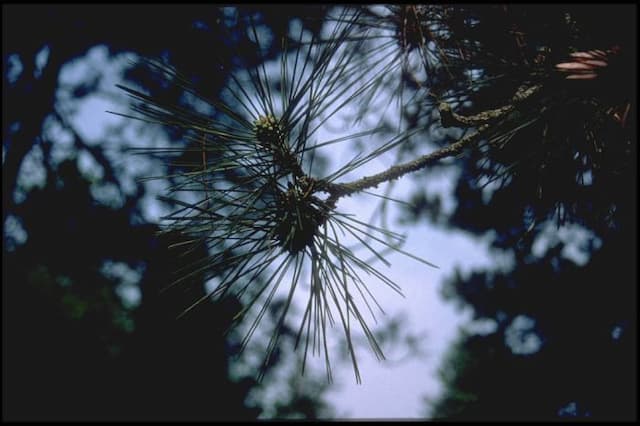Noble fir Abies procera

ABOUT
Abies procera, commonly known as the Noble Fir, is a striking plant admired for its beautiful appearance. The Noble Fir exhibits a symmetrical, pyramidal shape with a straight, sturdy trunk. Its branches grow in a dense, horizontal formation, giving it a full-bodied look that is often sought after for use as a Christmas tree. The foliage of the Noble Fir is a highlight, with needles that are bluish-green in color and that exhibit a lovely silver sheen. The needles are arranged spirally on the twig but are twisted at the base to lie flat on either side of the twig, which is a characteristic feature. These needles are typically about an inch long and possess a curved tip, unlike the more pointed tips seen in some other fir species. The dense foliage creates a lush appearance and a pleasant fragrance that is often associated with the holiday season. The bark of the Noble Fir is another notable feature, which starts smooth and gray in younger specimens and becomes furrowed, reddish-brown, and scaly as the plant matures. The plant also bears cones, which are upright and cylindrical, unlike the drooping cones of many other conifer species. These cones are quite striking, with their bracts extending beyond the scales, giving them a unique and decorative look reminiscent of the tails of exotic birds. The cones mature to a rich purple-brown, adding further interest to the plant's appearance. In summary, the Noble Fir is a majestic plant with a classical coniferous shape, vibrant bluish-green needles, and decorative cones. Its overall appearance is one of nobility and strength, making it a beloved feature in natural and landscaped settings alike.
About this plant
 Names
NamesFamily
Pinaceae
Synonyms
Noble Fir, Red Fir, Christmas Tree, Alaskan Fir, White Fir, Pacific Red Fir
Common names
Abies nobilis, Picea nobilis, Pinus nobilis, Pinus procera, Abies nobilis var. glauca, Abies nobilis subsp. procera, Abies procera var. glauca
 Toxicity
ToxicityTo humans
Noble fir, which is the common name for Abies procera, is not considered highly toxic to humans. However, eating parts of this plant, such as needles or sap, can potentially cause minor irritations or digestive discomfort. There are no severe symptoms of poisoning generally associated with the Noble fir for humans. Ingesting large quantities of any non-food plant can lead to gastrointestinal upset, therefore it is advisable to avoid eating this plant.
To pets
Noble fir is also known by the same common name for pets and is similarly not highly toxic to them. While it is not a common cause of poisoning, ingestion of the needles can lead to gastrointestinal irritation, vomiting, or diarrhea in pets. It is best to prevent pets from chewing on or ingesting parts of the Noble fir to avoid these possible symptoms.
 Characteristics
CharacteristicsLife cycle
Perennials
Foliage type
Evergreen
Color of leaves
Green
Height
60-70 feet (18-21 meters)
Spread
10-15 feet (3-4.5 meters)
Plant type
Tree
Hardiness zones
4
Native area
North America
Benefits
 General Benefits
General Benefits- Ornamental value: Noble fir is widely used as a Christmas tree due to its attractive symmetrical shape, dense foliage, and long-lasting needles.
- Wood production: The wood of the noble fir is strong and lightweight, making it suitable for general construction, plywood, and paper products.
- Wildlife habitat: Noble fir forests provide habitat for various wildlife species including birds, small mammals, and insects.
- Erosion control: With its extensive root system, it helps stabilize soil and prevent erosion in mountainous areas where it is native.
- Economic importance: The harvesting of noble fir for Christmas trees and timber provides economic benefits to local communities and industries.
- Recreational use: Noble fir forests are popular destinations for outdoor activities like hiking, bird watching, and camping, contributing to human well-being.
- Cultural significance: The noble fir holds cultural importance, especially in regions where it is used for celebratory events and traditions such as Christmas.
- Climate adaptation: Being a mountain species, noble fir is adapted to cold climates, making it an important species for montane ecosystems in a changing climate.
 Medical Properties
Medical PropertiesThis plant is not used for medical purposes.
 Air-purifying Qualities
Air-purifying QualitiesThis plant is not specifically known for air purifying qualities.
 Other Uses
Other Uses- The wood from Noble Fir is often used for paper production due to its long fibers, providing strength to papers like packaging and newsprint.
- Its resin can be used as a natural glue or adhesive as it is sticky and has binding properties.
- Noble Fir branches and foliage are popular for constructing Christmas wreaths and garlands, especially in the Pacific Northwest.
- The tree's wood chips are sometimes used as a natural mulch, offering soil protection and improving garden aesthetics.
- Due to its fragrance, dried bits of Noble Fir can be included in potpourri mixes, imparting a fresh, forest-like scent to a room.
- Noble Fir cones are used in decorative craft projects or as a natural, rustic décor for homes and events.
- The bark of the tree can be utilized in the creation of landscape mulch, promoting moisture retention in soil.
- It may also be a source for biomass energy production, converting wood waste from Noble Fir lumber operations into energy.
- The tree's branches are often used in floral arrangements as greenery to add fullness and a touch of nature.
- Noble Fir sap is sometimes used in making aromatic substances like essential oils or natural perfumes.
Interesting Facts
 Feng Shui
Feng ShuiThe Noble Fir is not used in Feng Shui practice.
 Zodiac Sign Compitability
Zodiac Sign CompitabilityThe Noble Fir is not used in astrology practice.
 Plant Symbolism
Plant Symbolism- Endurance and Longevity: The Noble fir, as Abies procera is commonly known, is a species that can live for hundreds of years, symbolizing the persistence and endurance needed to sustain a long and meaningful life.
- Resilience: Able to withstand cold climates and poor soil conditions, the Noble fir represents resilience and the ability to thrive in challenging environments.
- Strength: With its tall and straight trunk, the Noble fir is often associated with strength and stability, symbolizing the qualities needed to stand firm and unwavering in the face of adversity.
- Majesty and Elegance: The Noble fir's name itself suggests a regal quality, symbolizing majesty, beauty, and gracefulness in its stately presence.
- Purity: The evergreen nature of the Noble fir, combined with its pleasant fragrance, has been associated with purity and cleanliness, embodying a sense of perpetual freshness and vitality.
- Christmas Celebrations: As a popular Christmas tree, the Noble fir is linked with traditions of joy, generosity, and the spirit of giving during the holiday season.
 Water
WaterNoble Fir trees should be watered deeply and infrequently to mimic their natural habitat and encourage deep root growth. For established trees, watering once every two to three weeks is appropriate, adjusting for rainfall and soil type. During each watering session, aim to provide the equivalent of 1 inch of rainfall, which translates to about 0.6 gallons per square foot, depending on the size of your tree's root system. Newly planted trees require more frequent watering, about once a week, to ensure they establish well. Ensure the water penetrates the soil to a depth of at least 12 inches to reach the entire root zone.
 Light
LightNoble Firs thrive in full sun to partial shade, with at least six hours of direct sunlight each day being ideal. They prefer a location that receives morning sunlight and some afternoon shade, especially in hotter climates. Avoid planting in deep shade, as insufficient light can lead to poor growth and a sparse canopy.
 Temperature
TemperatureNoble Firs are hardy trees that can withstand a range of temperatures, from as low as -40°F to highs of 80°F. They are well-suited to cooler climates and grow best with a median temperature range between 60°F to 70°F during the growing season. It is important to avoid exposure to extremes on either end for extended periods, as this could damage the tree.
 Pruning
PruningPruning of Noble Firs is usually unnecessary unless to remove dead or damaged branches or to shape young trees. The best time to prune is late winter or early spring before new growth begins. Pruning should be done sparingly, as these trees naturally maintain a good shape, and cutting back too far can damage the tree's form.
 Cleaning
CleaningNot needed
 Soil
SoilNoble fir prefers a well-draining, acidic soil mix with a pH ranging approximately from 5.5 to 6.0. A mix containing one part peat, one part perlite, and one part loam is suitable.
 Repotting
RepottingNoble firs are typically not repotted as they are large trees best suited for outdoor growing; instead, transplant them into the landscape after a few years if grown in pots.
 Humidity & Misting
Humidity & MistingNoble fir thrives in moderate to high humidity levels typical of its native mountainous habitats, but it is adaptable and can tolerate lower humidity.
 Suitable locations
Suitable locationsIndoor
Ensure bright light, cool temperatures, and avoid dry heat for Noble fir.
Outdoor
Plant Noble fir in sunlight with well-drained soil; protect from wind.
Hardiness zone
Noble fir is suitable for USDA zones 6-8.
 Life cycle
Life cycleThe noble fir, Abies procera, begins its life cycle as a seed, commonly dispersed by wind or animals, which germinates in moist, well-drained soil during the spring. Upon successful germination, a seedling emerges and, if it survives the vulnerable juvenile phase, will grow into a sapling, gradually developing a conical shape characteristic of young fir trees. With adequate light, water, and nutrients, the sapling matures into an adult tree over many years, reaching its full size and developing the species' distinctive tall, straight trunk and symmetrical branch pattern. The mature noble fir then produces cones; the female cones grow at the top of the tree while male cones are typically found further down, and these release pollen that fertilizes the female cones during the spring. The fertilized cones develop seeds, which complete the reproductive cycle when they mature and are eventually released to start a new generation. In ideal conditions, a noble fir can live for several hundred years, continuing to produce seeds annually once it reaches maturity.
 Propogation
PropogationPropogation time
Spring-early summer
The Noble Fir, scientifically known as Abies procera, is commonly propagated through seed sowing. The best time to sow Noble Fir seeds is in late winter or spring. The seeds require a period of cold stratification for about a month to break dormancy which can be done by placing them in a refrigerator at about 34-40 degrees Fahrenheit (1-4 degrees Celsius). After stratification, seeds are sown in well-drained soil and lightly covered. They should be kept moist and in a light but not direct sunlight environment. Germination usually occurs within a few weeks to a couple of months, and the young seedlings require careful nurturing until they are strong enough to be transplanted outdoors.









